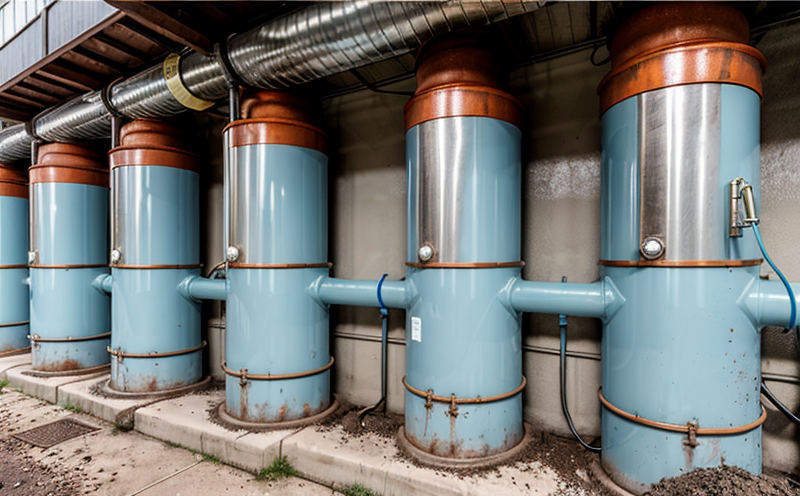ASTM G202 Scaling Deposit Formation Test in Water Systems
The ASTM G202 standard practice provides a method to determine the potential for scaling and deposit formation within water systems. This test is critical for ensuring that the materials used in these systems are resistant to corrosion, scaling, and the buildup of deposits, which can lead to inefficiencies or even failures.
Scaling and deposits can significantly impact the performance and longevity of water systems by reducing flow rates, increasing energy consumption, and potentially leading to equipment failure. By identifying materials that resist these phenomena early in the product development process, quality managers, compliance officers, and R&D engineers can make informed decisions that enhance system reliability.
The ASTM G202 method involves exposing test coupons of candidate materials to a water solution under defined conditions. The exposure time is typically 14 days, after which the samples are inspected for signs of scaling or deposit formation. This test is particularly useful in sectors like HVAC (Heating, Ventilation, and Air Conditioning) systems, plumbing fixtures, and industrial cooling towers.
One of the key challenges in water systems is selecting materials that can withstand harsh environments. The ASTM G202 method helps address this by providing a standardized approach to evaluate material performance. This ensures consistency across different testing facilities and allows for accurate comparison between various materials. For instance, in an HVAC system, understanding which pipe material resists scaling can prevent costly downtime due to clogged pipes.
Another critical aspect of the ASTM G202 test is its role in compliance with industry standards. Many organizations have specific requirements regarding the resistance of their products to corrosion and scaling, making this test an essential tool for quality assurance departments. Compliance officers can use the results from ASTM G202 to ensure that their products meet these stringent requirements.
The method also plays a vital role in R&D efforts by providing insights into how different materials behave under specific conditions. Engineers can use the data generated from this test to improve product design and enhance material selection processes. For example, if a particular alloy shows excellent resistance to scaling but poor corrosion resistance, it may be necessary to modify the formulation or choose an alternative material.
| Parameter | Description |
|---|---|
| Test Coupons | Cut from the candidate material, typically 25 mm x 10 mm x 3 mm. |
| Water Solution | A saturated calcium carbonate (CaCO₃) solution at a pH of 8.7 ± 0.2 and a temperature of 24°C ± 1°C. |
| Exposure Time | 14 days, with daily inspection for any signs of scaling or deposit formation. |
Scope and Methodology
The ASTM G202 Scaling Deposit Formation Test is designed to evaluate the potential for scaling and deposit formation in water systems. The test involves exposing metal coupons to a controlled environment that simulates real-world conditions, allowing for the assessment of material performance.
- Test Coupons: Metal samples are cut from candidate materials to standard dimensions (25 mm x 10 mm x 3 mm).
- Water Solution: A saturated calcium carbonate solution with a pH of 8.7 ± 0.2 and a temperature of 24°C ± 1°C is used.
- Exposure Time: The samples are exposed to the water solution for 14 days, during which they are inspected daily for signs of scaling or deposit formation.
The test provides valuable information on how different materials behave in a simulated water environment. This is particularly useful for industries like HVAC, plumbing, and industrial cooling where material selection can significantly impact system performance and longevity.
By following the ASTM G202 method, laboratories ensure that their testing meets international standards, providing reliable data that can be trusted by quality managers, compliance officers, and R&D engineers. This standardized approach helps in making informed decisions about material selection and product design, ultimately leading to more efficient and reliable water systems.
Customer Impact and Satisfaction
The ASTM G202 Scaling Deposit Formation Test has a significant impact on customer satisfaction by ensuring that the materials used in water systems are reliable and perform as expected. Quality managers, compliance officers, and R&D engineers rely on this test to select materials that resist scaling and deposit formation, thereby enhancing system performance.
One of the main benefits for customers is improved system efficiency. By using materials that resist scaling, energy consumption in HVAC systems can be reduced, leading to lower operational costs. Similarly, in industrial cooling towers, the use of materials resistant to deposition helps maintain optimal heat transfer rates, ensuring consistent and efficient operation.
Another important aspect is extended equipment life. Materials that resist corrosion and deposit formation are less likely to fail prematurely, reducing maintenance needs and associated downtime. This not only saves time and money but also ensures continuous operation of critical water systems.
Customer satisfaction is further enhanced by the ability to comply with industry standards. Many organizations have specific requirements for material resistance to scaling and corrosion, making ASTM G202 a vital tool for ensuring compliance. This helps in maintaining a good reputation and trust among customers.
In summary, the ASTM G202 Scaling Deposit Formation Test plays a crucial role in improving system performance, extending equipment life, and ensuring compliance with industry standards. These factors contribute significantly to customer satisfaction and loyalty.
Environmental and Sustainability Contributions
- Energy Efficiency: Materials resistant to scaling can reduce the need for frequent cleaning, thereby lowering energy consumption in HVAC systems.
- Resource Conservation: By selecting materials that resist deposit formation, less water is wasted, contributing to overall resource conservation.
- Emissions Reduction: Enhanced efficiency leads to lower emissions from industrial processes and buildings, promoting a more sustainable environment.
- Solid Waste Management: Less frequent cleaning and maintenance reduce the amount of solid waste generated in water systems.
The ASTM G202 Scaling Deposit Formation Test supports these environmental contributions by helping to select materials that are durable, efficient, and sustainable. This not only benefits individual organizations but also contributes positively to global sustainability efforts.





